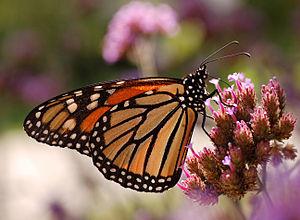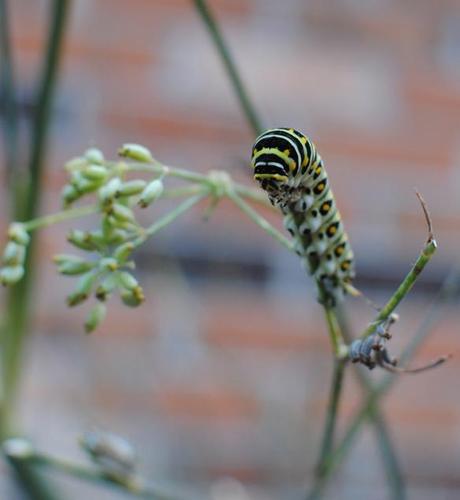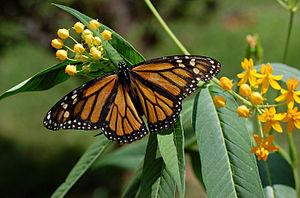
Monarch Butterfly Danaus plexippus Proboscis 2591px (Photo credit: Wikipedia)
Now that fall is here, and life in the garden is beginning to slow down (ever so slightly), I am thinking about next year’s garden.
It’s been a wonderful summer here for swallowtail butterflies. I enjoy spotting the caterpillars that continue, even now, to overwhelm my small stands of bronze fennel (one of the construction workers building our addition said he counted 19 on one plant last week!).

A very hungry swallowtail caterpillar munches my bronze fennel to its core.
But as you may have heard if you live in the US, this has been a bad year for monarch butterflies (Danaus plexippus). Habitat destruction and widespread use of pesticides have contributed to profound declines in numbers over the past few years. In the past, I have tried to grow plants attractive to all kinds of pollinators, but as I plan for Winter Sowing 2.0, I intend to sow and plant for monarchs in particular.
Monarch larvae feed on milkweed (Asclepias sp.), and females will only lay their eggs on these plants. Different species of milkweed are recommended for different areas of the US: Monarch Joint Venture has a map and fact sheet about them.
But migrating butterflies need nectar plants as well. Monarch Watch is a wonderful source of information on ways to help contribute to conservation of this species (as well as other butterfly species), including recommended nectar plants. I think my household may try to become certified as a Monarch Waystation next year (I feel a Girl Scout project coming on).

Photograph of a female Monarch Butterfly en ( Danaus plexippus en ) on a hybrid Milkweed en ( Asclepias tuberosa en x Asclepias incarnata en ). (Photo credit: Wikipedia)
Many milkweeds species perform well with winter sowing–a technique in which the gardener sows seed in a simple pot or flat and leaves it exposed to the elements all winter long. The gardener doesn’t tend the seedlings until it’s time to pot them on. It couldn’t be easier–so there is little excuse for me to not try to help this beloved and charismatic species recover from the challenges it has suffered.
I hope that, if you garden in North America, you will explore resources like Monarch Watch and Monarch Joint Venture to find out ways you can help. There are wonderful citizen science programs around through which gardeners and homeowners can assist with migration tracking and population counts. No garden is too small to contribute to the conservation of these creatures.
WebRep currentVote noRating noWeight
